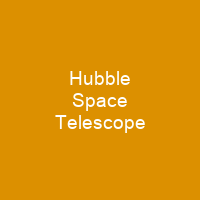The Hubble Space Telescope: A Journey Through the Cosmos
Imagine a telescope that has been gazing into the vast expanse of space for over three decades, capturing images that have revolutionized our understanding of the universe. The Hubble Space Telescope, launched in 1990, is not just any ordinary observatory—it’s a marvel of engineering and scientific ingenuity. But how did this incredible machine come to be? And what makes it so special?
The Visionary Behind Hubble
Spurred by the vision of Nicholas U. Mayall, who first proposed a space telescope in 1946, and driven by the relentless efforts of Nancy Grace Roman, often referred to as the ‘Mother of Hubble,’ this project took shape. Nancy’s public lectures and tireless advocacy laid the groundwork for what would become one of humanity’s most iconic scientific instruments.
From Concept to Reality
The journey from concept to reality was fraught with challenges, including budget constraints and technical issues. The telescope initially launched with a flawed mirror but was corrected in 1993 through a servicing mission. This pivotal moment not only fixed the problem but also demonstrated the potential of space-based telescopes.
Space-Based Observations: A New Era
Spitzer’s Vision: In 1962, a report by the U.S. National Academy of Sciences recommended developing a space telescope as part of the space program. This was the beginning of what would become the Hubble Space Telescope.
The Early Days: Small Steps in Space
Before Hubble, smaller space-based telescopes had already made significant strides. The first ultraviolet spectrum of the Sun was obtained in 1946, and NASA launched the Orbiting Solar Observatory (OSO) to obtain UV, X-ray, and gamma-ray spectra in 1962. These early missions laid the foundation for what Hubble would achieve.
The Large Space Telescope: A Giant Leap
In 1970, NASA established two committees—one to plan the engineering side of the space telescope project, and another to determine its scientific goals. The Large Space Telescope (LST) was initially planned for a launch in 1979 but faced numerous delays due to budget issues and technical challenges.
Construction and Challenges
The construction of Hubble began in 1979, with the mirror being built by Perkin-Elmer. However, this process was fraught with difficulties, leading to a flawed primary mirror that caused severe spherical aberration. This flaw affected high-contrast imaging but not spectroscopy of point sources.
The Corrective Optics Space Telescope Axial Replacement (COSTAR)
To correct the spherical aberration, NASA developed the COSTAR system, which was installed during the first servicing mission in 1993. This innovative solution effectively acted as ‘spectacles’ to correct the mirror’s error.
Service Missions and Upgrades
Hubble has undergone five Space Shuttle missions for repairs and upgrades, with the final one taking place in May 2009. These missions not only fixed problems but also installed new instruments, ensuring that Hubble remained a cutting-edge observatory.
The Servicing Missions: A Lifeline
Each servicing mission was crucial for maintaining and enhancing Hubble’s capabilities. For instance, the first mission in 1993 involved extensive work to install corrective optics, while subsequent missions replaced instruments and upgraded equipment.
Astronomical Discoveries and Legacy
Hubble has made numerous groundbreaking discoveries, including measuring the age of the universe, studying black holes, and capturing images of distant galaxies. Its data has been used in over 15,000 peer-reviewed papers, significantly advancing our understanding of the cosmos.
Public Engagement: A Key to Success
NASA recognized early on that public engagement was crucial for Hubble’s success. The corrected optics produced numerous remarkable images, helping to rehabilitate its reputation and capture the public’s imagination.
The Future of Space Telescopes
While Hubble is set to last until 2030-2040, it will eventually be replaced by more advanced telescopes. The James Webb Space Telescope, for instance, will detect stars in the early universe approximately 280 million years older than those Hubble now detects.
Conclusion: A Legacy of Innovation and Discovery
The Hubble Space Telescope has been a beacon of scientific achievement, pushing the boundaries of what we know about our universe. Its journey from flawed beginnings to becoming one of humanity’s greatest tools for exploring space is a testament to human ingenuity and perseverance.

You want to know more about Hubble Space Telescope?
This page is based on the article Hubble Space Telescope published in Wikipedia (retrieved on March 9, 2025) and was automatically summarized using artificial intelligence.





